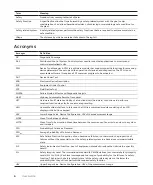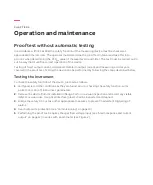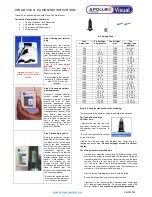
—
Ch A p TEr 4
Installation and commissioning
Only qualified and authorized specialists should be charged with the installation, electrical connection,
commissioning, operation, and maintenance of LLT100 instruments.
Installation
The level laser transmitter must be installed with standard practices outlined in the Operating
Instructions manual. Environmental parameters, such as temperature, pressure and dust level to
name a few, must be checked to verify that they do not exceed the LLT100 ratings . As far as possible,
the measuring setup should be free from critical ambient conditions such as large variations in
temperature, vibrations, or shocks.
Physical location and placement
The LLT100 shall be accessible with sufficient room for electrical connection and shall allow manual
proof testing, as described in “Proof test without automatic testing” on page 23.
In liquid applications, the laser beam must be as perpendicular as possible to the liquid surface.
Alignment of the beam shall be within ±5 degrees from vertical.
In solid applications, if the laser is installed with an angle, the setting level calibration points in AD1 shall
be executed to calibrate the actual depth of the monitored vessel with the measured depth.
Electrical connection
See the Operating Instructions manual for electrical connection instructions. Connection details like
wires gauge and maximum length of cable are described in this manual. Make sure that the LLT100
is grounded according to the national and local electrical code. Outside installations or installations
exposed directly or indirectly to lightning discharges should have a secondary lightning protection
module.
Do NOT
make electrical connections unless the electrical code designation stamped on the LLT100
name plate matches the classification of the area in which you want to install the LLT100.
Commissioning
The LLT100 needs to be configured before first use, since it comes with a factory default configuration.
This instrument can be configured with the local HMI, with the DTM via the HART interface or with
a handheld terminal. Configuring the device with the local HMI is documented in the Operating
Instructions. During configuration, safe operation of the device shall not be assumed.
Summary of Contents for LLT100
Page 1: ...LLT SIL FUNCTIONAL SAFET Y GUIDE LLT100 Laser level transmitter...
Page 4: ...Page intentionally left blank...
Page 8: ...Page intentionally left blank...
Page 18: ...18 User Guide...
Page 22: ...Page intentionally left blank...
Page 26: ...Page intentionally left blank...
Page 30: ...Page intentionally left blank...
Page 31: ......











































